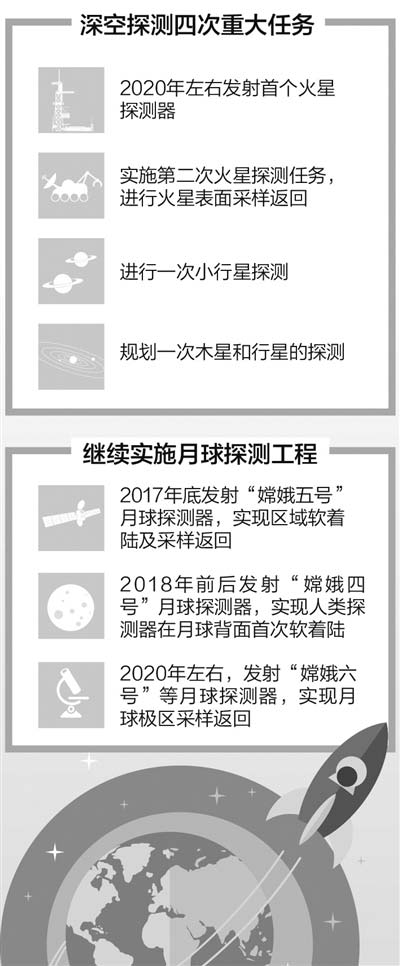China's space: strive to 2030 among space powers

Around 2020, China to launch its first Mars probe
China is expected to launch in the next decade by about 100 satellites
To 2030 among space powers (in Scio press conference)
China's State Council information Office published on December 27 the 2016 white paper on China's space, summarizes the main developments of 2011, China Aerospace, and the next five years to accelerate the construction pace of aerospace power, strive for 2030 years ranks among the world's space powers.
The Chinese Government published the fourth white paper on space. Deputy Director of the China National Space Administration said Wu Yanhua, vision for Aerospace power development was first proposed in the white paper, and for the next five years and future aerospace development priorities and directions in this paper. The Chinese Government officially released national space infrastructure over the next decade the priorities of the medium-and long-term planning. According to reports, over the next decade, China is expected to be about 100 satellites to be launched.
Around the year 2020 to launch its first Mars probe
White paper on the development of future space major projects in detail. In the area of deep space exploration, introduced Wu Yanhua, in January of this year, China approved the first Mars mission, space from the moon to deep space exploration, China marked the wider universe.
He said future deep space exploration project will implement four major tasks. 2020 is about to launch its first Mars probe, carried out in accordance with a step around, fall, visiting Mars; the second is a second Mars missions, Mars sample return, structure and composition of Mars, Mars scientific analysis and research; the third is another asteroid detection; four were planning a Jupiter and the planet's detection.
In addition, China will continue to implement the lunar exploration project, break detector celestial automatic sample return technologies. Will in 2017 end of launches "Chang fifth," Moon detector, achieved regional landing and the sampling returns, full achieved Moon detection engineering "three step go" strategy target; 2018 before and after launches "Chang fourth," Moon detector, achieved human detector in moon back first landing, carried out in situ and visits detection, and to months L2 points relay communications; also will Yu 2020 around, launches "Chang sixth,", Moon detector, achieved Moon very district sampling returns.
Next-generation heavy rocket flight in 2030
According to a white paper in the next five years, China will accelerate the pace of aerospace power building, the implementation of some major projects. Wu Yanhua said, starting the development of a next-generation heavy rocket research in China, to be named "long Nineth" reasoning deepen ongoing project and key technology research, preliminary plans for heavy carrier rocket first flew around 2030.
Wu Yanhua also focused on another major project--a national "Thirteen-Five" world of planning integrated information network system for major science and technology projects. After the completion, without communication obstacles in any place around the world truly in accordance with the 5G development of the communications industry, real-time connectivity.
In addition, China will also continue to implement the manned spaceflight, lunar exploration, the Beidou navigation satellite system, high-resolution Earth observation system has major aerospace projects. Among them, the manned space program will launch "day boat first" cargo spacecraft, in orbit and "temple on the second" space laboratory for rendezvous and docking, around 2020, completed construction and operation station Assembly in orbit. Beidou navigation system will be completed by around 2020 of 35 satellites launch network. High resolution Earth observation system will be completed by around 2020 system, formation of high spatial resolution and high temporal resolution, high spectral resolution Earth observation capacity.
The next five years, China will also accelerate the construction of basic facilities construction formed broadcast satellite remote sensing, satellite communications, satellite navigation and positioning the three systems, promoting the development of satellites and applications industry. Among them, for monitoring atmospheric pollution, global climate change and other pressing needs of development launched terrestrial carbon monitoring, atmospheric environment new satellites such as laser detection.
On the issue of investment in social care, the white paper, perfect space diversified investment system, promoting Government cooperation with the social capital, and perfect government purchasing mechanism for space products and services.
"Link"
China's space achievements
According to a white paper since 2011, China's space development and fruitful.
Remarkable achievements of aerospace science and technology innovation. Shenzhou Nineth,, and tenth, and Temple first,, Shenzhou 11th, and Temple second, success rendezvous docking, manned space breakthrough master has key technology; Chang third, first achieved China spacecraft to outside objects landing and months surface visits detection, exploration months engineering three period again into returns flight test made successfully success; Beidou second, system full built, global system construction speed up advance; high resolution on to observation system 6 star satellite Success launches and input using; dark material particles detection, and quantum communications experiment, space science satellite Success launches.
Access to space capacity to achieve leapfrog development. Long March rocket series implemented 86 launches, success rate of 97.7%; long fifth successful launch for a new generation of large launch vehicle, launch vehicle spectrum further improved.
Use of space capabilities has increased significantly. Space infrastructure for long-term development plan released, system-building accelerated. Up to now, the Chinese satellite in orbit more than 170.
Deepening the development of international cooperation. Up to now, China and more than 30 countries, space agencies and international organizations more than more than 100 cooperation agreements signed; realization of 5 satellites satellite exports and in-orbit delivery.
(Editors: Zheng Jiang UN988)
2016-12-28 10:58:12
People's daily online
中国航天:力争2030年跻身航天强国

2020年左右中国发射首个火星探测器
未来十年中国预计发射约100颗卫星
力争2030年跻身航天强国(在国新办新闻发布会上)
中国国务院新闻办12月27日发表《2016中国的航天》白皮书,总结了2011年以来中国航天的主要进展,并提出未来五年将加快航天强国建设步伐,力争2030年左右跻身世界航天强国行列。
这是中国政府发布的第四部航天白皮书。中国国家航天局副局长吴艳华表示,白皮书首次提出航天强国发展愿景,同时对未来五年及今后一个时期航天发展重点和方向进行系统阐述。这也是中国政府正式发布未来十年国家空间基础设施中长期规划的重点任务。据介绍,未来十年中国预计将发射约100颗卫星。
2020年左右发射首个火星探测器
白皮书对未来航天发展的重大工程都做了详细表述。在深空探测方面,吴艳华介绍,中国今年1月份正式批准了首次火星探测任务,标志着中国航天深空探测将由月球迈向更深远的宇宙。
他透露,未来的深空探测工程还将实施四次重大任务。一是2020年左右发射首个火星探测器,按照一步实现绕、落、巡开展火星探测;二是实施第二次火星探测任务,进行火星表面采样返回,开展火星构造、物质成分、火星环境等科学分析与研究;三是进行一次小行星探测;四是规划一次木星和行星的探测。
此外,中国还将继续实施月球探测工程,突破探测器地外天体自动采样返回技术。将在2017年底发射“嫦娥五号”月球探测器,实现区域软着陆及采样返回,全面实现月球探测工程“三步走”战略目标;2018年前后发射“嫦娥四号”月球探测器,实现人类探测器在月球背面首次软着陆,开展原位和巡视探测,以及地月L2点中继通信;还将于2020年左右,发射“嫦娥六号”等月球探测器,实现月球极区采样返回。
下一代重型运载火箭或将2030年首飞
白皮书显示,未来五年,中国将加快航天强国建设步伐,实施一些重大工程。吴艳华透露,中国正在启动下一代重型运载火箭的研制攻关,拟命名为“长征九号”,目前正在开展方案深化论证和关键技术攻关,初步计划重型运载火箭的首飞时间是2030年左右。
吴艳华还重点介绍了另一个重大工程——列为国家“十三五”规划的天地一体化信息网络系统重大科技工程。建成以后,将在全球任何地点没有通信传输障碍,能够真正按照通信行业5G发展方向,做到实时的互联互通。
此外,中国还将继续实施好载人航天、月球探测、北斗导航卫星系统、高分辨率对地观测系统等已有航天重大专项。其中,载人航天工程将发射“天舟一号”货运飞船,与在轨运行的“天宫二号”空间实验室进行交会对接,2020年左右,完成空间站在轨组装建造和运营。北斗卫星导航系统将于2020年左右完成35颗卫星发射组网。高分辨率对地观测系统将于2020年左右完成系统建设,形成高空间分辨率、高时间分辨率、高光谱分辨率对地观测能力。
未来五年,中国还将加快建设空间基础设施,构建形成卫星遥感、卫星通信广播、卫星导航定位三大系统,促进卫星及应用产业发展。其中,面向大气污染、全球气候变化监测等方面的迫切需求,研制发射陆地生态碳监测、大气环境激光探测等新型卫星。
在社会关心的投入问题上,白皮书提出,健全完善航天多元化投入体系,推动政府与社会资本合作,完善政府购买航天产品与服务机制。
【链 接】
中国航天成果丰硕
白皮书显示,2011年以来,中国航天快速发展,成果丰硕。
航天科技创新成果显著。神舟九号、十号与天宫一号,神舟十一号与天宫二号成功交会对接,载人航天突破掌握了关键技术;嫦娥三号首次实现中国航天器地外天体软着陆和月面巡视探测,探月工程三期再入返回飞行试验取得圆满成功;北斗二号系统全面建成,全球系统建设加快推进;高分辨率对地观测系统6颗卫星成功发射并投入使用;暗物质粒子探测、量子通信实验等空间科学卫星成功发射。
进入空间能力取得跨越发展。长征系列运载火箭共实施86次发射,成功率达97.7%;新一代大型运载火箭长征五号等成功发射,运载火箭型谱进一步完善。
利用空间能力大幅提升。空间基础设施中长期发展规划正式发布,系统建设加快推进。截至目前,中国在轨卫星超过170颗。
国际合作深化拓展。截至目前,中国共与30多个国家、空间机构和国际组织签署100余项合作协定;实现5颗卫星整星出口和在轨交付。
(责任编辑:郑江 UN988)
2016-12-28 10:58:12
人民网